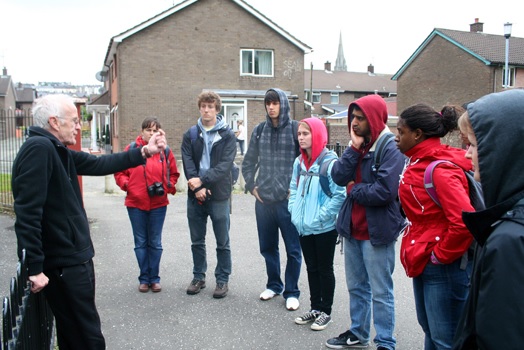
In many ways, the education sector is the most appropriate medium for reaching young adult citizens and introducing them both to the violent past and its varied legacies, as well as to the transitional justice measures used to redress and record them. It is also the most appropriate medium for embodying and passing on the skills, dispositions, and behaviors that must be learned in order to nurture and protect democratic citizenship and human rights. While many transitional justice measures are temporary and focus on the first generation emerging from conflict, education has the potential to reach both the first generation and subsequent generations that become increasingly responsible for upholding the new norms and protections put in place during a country’s transition.
Conflict is sometimes exacerbated by the education sector and repressive regimes often use education as one of their primary tools of oppression. This makes reforms particularly important during transitions. These reforms commonly include policy changes such as the introduction of new norms and the removal of policies of the former regime. A critical – and overlooked – area of consideration for structural reforms in education within the context of transitional justice is segregation by identity group. In many divided societies, schools are intensely segregated, reflecting the socio-political norms more widely at work.
Two such societies worthy of further examination are Bosnia and Northern Ireland, both divided societies with identity-based conflicts and with violent struggles in their recent pasts.
While there is much to distinguish between the particular contexts and conflicts of Northern Ireland and Bosnia, the countries do have a great deal in common, particularly regarding education and transition. The way that a country’s conflict ends profoundly shapes and informs its transition, and the conflicts in Bosnia and Northern Ireland were both ended by negotiated settlements: the Dayton Accords in 1995 and the Belfast Agreement in 1998, respectively. In both cases, education-related issues, such as interpretations of the past and its legacies, were key factors at the root of the conflicts but were largely neglected. The agreements themselves legitimated segregation based on ethnic and religious identity. The fear of group identity being threatened or subsumed by another permeates both agreements and provides a window into some of the challenges that both countries face, particularly within the educational arena.
In Bosnia, the unwieldy governmental structure has itself proven to be an obstacle to reform. Efforts to integrate schools and reform curricula have been stymied by both the post-Dayton governmental structure and by the fears of citizens.
“For the majority of people, especially the Bosnian Croats and the Bosnian Serbs integration is understood as either the return to the prewar Yugoslav ethnic relations or as an assimilation into a larger, dominant group and a related loss of ethnocultural identity,” says Dr. Azra Hromadžic, a cultural anthropologist specializing in post-war transformation. “Both are seen as dangerous to the survival of the ethnically defined communities.”
Within this context the Dayton Accords have been used as a tool to maintain separateness; efforts to desegregate have stalled, resulting in practices such as the “two schools under one roof” phenomenon. Under this regime, students of different ethnicities – primarily Bosniak and Bosnian Croat children in the Federation of BiH entity – attend the same school but are physically separated, attending classes at different times in order not to mix and working with different curricula.
Education reforms have the best chance of making a positive difference when they are consistent with a wider set of policies and norms. Without a more comprehensive transitional justice framework implemented in either country, it is difficult to imagine substantive educational reforms sticking.
Leaving education out of these transitions risks undoing them, but focusing on education alone often translates into little large-scale change and places teachers, administrators, and – most importantly, students – potentially in harm’s way as they tackle challenges that society has abandoned.
Both countries can draw lessons from the experience of South Africa as it transitioned from apartheid, during which South Africa’s racially divided educational system allocated the lion’s share of resources – books, school facilities, teacher training programs, etc. – to white schools, while schools for black children suffered from a fundamental lack of resources and often sought to “train” students not to think or excel.
The most effective reforms are part of a wider transitional justice framework. Within education, for example, asking students to take risks that adults refuse to take will result in failure and in frustration, as will reforms that isolate teachers, classrooms, schools, and the educational system as a whole from wider support. South Africa’s relative success is tied to the comprehensive and consistent approach – from leadership through to the reform and transformation of institutions – that the country took toward reconstruction, reconciliation, and repair.
A vital aspect of South Africa’s transition was the way that the country dealt with its violent past – it became central, visible, and legitimate. Importantly, in this process South Africans view the state as a force of social cohesion, not conflict.
Bosnia and Northern Ireland, on the other hand, share the significant challenge that the state itself is not a point of cohesion for their citizens, but a source of conflict. Unless and until this overriding issue is addressed and a wider framework adopted, transitional justice measures, including those made through education, will be limited both in scope and in impact.
This article was first published by the ICTJ. Later this year, the ICTJ will publish "Transitional Justice and Education: Learning Peace," a new edited volume exploring the ways in which societies can harness education to address the legacies of past human rights abuses.
ICTJ experts will be previewing their research as they investigate education in contexts around the globe. "Transitional Justice and Education: Learning Peace" is part of a larger project, which you can learn more about here.



